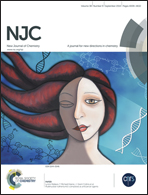Synthesis of tunable ZnS–CuS microspheres and visible-light photoactivity for rhodamine B†
Abstract
Tunable ZnS–CuS microspheres were readily prepared via replacing the Zn2+ ions of solid ZnS microspheres with Cu2+ ions in an aqueous solution under a hydrothermal condition, and were then characterized by XRD, SEM, TEM, UV-Vis, PL and XPS techniques. The thickness of CuS shell on the surface of ZnS core can be controlled by changing the ion-exchange time, which plays an important role in the visible light photodegradation efficiency of rhodamine B in aqueous solution. Degradation rate can rapidly reach ca. 72% under visible light irradiation for 15 min and then ca. 98% after 60 min using the ZnS–CuS microspheres as the photocatalyst.


 Please wait while we load your content...
Please wait while we load your content...